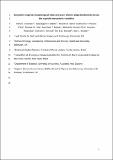Files in this item
Ecosystem engineer morphological traits and taxon identity shape biodiversity across the euphotic-mesophotic transition
Item metadata
| dc.contributor.author | Voerman, Sofie E | |
| dc.contributor.author | Marsh, Beauregard C | |
| dc.contributor.author | Bahia, Ricardo G | |
| dc.contributor.author | Pereira-Filho, Guilherme H | |
| dc.contributor.author | Yee, Thomas W | |
| dc.contributor.author | Becker, Ana Clara F | |
| dc.contributor.author | Amado-Filho, Gilberto M | |
| dc.contributor.author | Ruseckas, Arvydas | |
| dc.contributor.author | Turnbull, Graham A | |
| dc.contributor.author | Samuel, Ifor D W | |
| dc.contributor.author | Burdett, Heidi L | |
| dc.date.accessioned | 2022-05-12T14:30:27Z | |
| dc.date.available | 2022-05-12T14:30:27Z | |
| dc.date.issued | 2022-02-23 | |
| dc.identifier | 278117611 | |
| dc.identifier | eec05b2c-c146-450f-8768-07ef7b0f44b7 | |
| dc.identifier | 35193402 | |
| dc.identifier | 85125156238 | |
| dc.identifier | 000759381700008 | |
| dc.identifier.citation | Voerman , S E , Marsh , B C , Bahia , R G , Pereira-Filho , G H , Yee , T W , Becker , A C F , Amado-Filho , G M , Ruseckas , A , Turnbull , G A , Samuel , I D W & Burdett , H L 2022 , ' Ecosystem engineer morphological traits and taxon identity shape biodiversity across the euphotic-mesophotic transition ' , Proceedings of the Royal Society B: Biological Sciences , vol. 289 , no. 1969 , 20211834 . https://doi.org/10.1098/rspb.2021.1834 | en |
| dc.identifier.issn | 0962-8452 | |
| dc.identifier.other | ORCID: /0000-0001-9114-3522/work/109316072 | |
| dc.identifier.uri | https://hdl.handle.net/10023/25353 | |
| dc.description | Funding was provided by a Leverhulme Trust Research Project grant (no. RPG-2018-113) to H.L.B., G.A.T. and I.D.W.S., an Engineering and Physical Sciences Research Council grant (no. EP/L017008/1) to G.A.T. and I.D.W.S., and a São Paulo Research Foundation (FAPESP) individual grant (no. 2016/14017-0) to G.H.P.F. | en |
| dc.description.abstract | The euphotic-mesophotic transition is characterized by dramatic changes in environmental conditions, which can significantly alter the functioning of ecosystem engineers and the structure of their associated communities. However, the drivers of biodiversity change across the euphotic-mesophotic transition remain unclear. Here, we investigated the mechanisms affecting the biodiversity-supporting potential of free-living red coralline algae-globally important habitat creators-towards mesophotic depths. Across a 73 m depth gradient, we observed a general decline in macrofaunal biodiversity (fauna abundance, taxon richness and alpha diversity), but an increase in beta-diversity (i.e. variation between assemblages) at the deepest site (86 m depth, where light levels were less than 1% surface irradiance). We identified a gradient in abundance decline rather than distinct ecological shifts, driven by a complex interaction between declining light availability, declining size of the coralline algal host individuals and a changing host taxonomy. However, despite abundance declines, high between-assemblage variability at deeper depths allowed biodiversity-supporting potential to be maintained, highlighting their importance as coastal refugia. | |
| dc.format.extent | 6 | |
| dc.format.extent | 320706 | |
| dc.language.iso | eng | |
| dc.relation.ispartof | Proceedings of the Royal Society B: Biological Sciences | en |
| dc.subject | Ecosystem shift | en |
| dc.subject | Mesophotic reef | en |
| dc.subject | Maerl | en |
| dc.subject | Biogenic habitat | en |
| dc.subject | Rhodolith | en |
| dc.subject | GE Environmental Sciences | en |
| dc.subject | QH301 Biology | en |
| dc.subject | DAS | en |
| dc.subject | AC | en |
| dc.subject.lcc | GE | en |
| dc.subject.lcc | QH301 | en |
| dc.title | Ecosystem engineer morphological traits and taxon identity shape biodiversity across the euphotic-mesophotic transition | en |
| dc.type | Journal article | en |
| dc.contributor.sponsor | The Leverhulme Trust | en |
| dc.contributor.sponsor | EPSRC | en |
| dc.contributor.institution | University of St Andrews. Organic Semiconductor Centre | en |
| dc.contributor.institution | University of St Andrews. School of Physics and Astronomy | en |
| dc.contributor.institution | University of St Andrews. Sir James Mackenzie Institute for Early Diagnosis | en |
| dc.contributor.institution | University of St Andrews. Centre for Biophotonics | en |
| dc.contributor.institution | University of St Andrews. Condensed Matter Physics | en |
| dc.identifier.doi | 10.1098/rspb.2021.1834 | |
| dc.description.status | Peer reviewed | en |
| dc.identifier.grantnumber | RPG-2018-113 | en |
| dc.identifier.grantnumber | ep/l017008/1 | en |
This item appears in the following Collection(s)
Items in the St Andrews Research Repository are protected by copyright, with all rights reserved, unless otherwise indicated.

